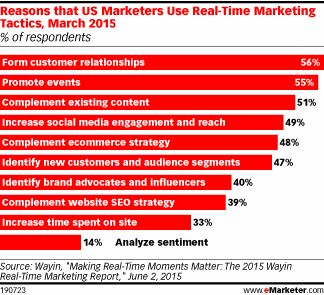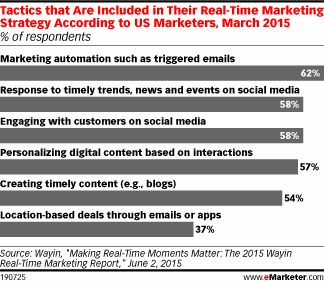Real-time marketing has become a thing in this business world, mainly because of how effectively marketers can reach goals using it — and not just for social media, mind you. In fact, these techniques have become a vital way to increase funding, with plenty of benefits as a result, according to a report from eMarketer.

A March 2015 report from Wayin, featuring results produced through 200 marketers in the U.S., indicates that marketers use it for various reasons. The top one, as you can see below, is forming and keeping customer relations intact with 56 percent. Closely behind are the ability to promote events (at 55 percent) and complementing existing content (51 percent). Meanwhile, lower reasons on the chart include increasing time spent on a company’s site (33 percent) and analyzing certain sentiments (14 percent).
The study also shows that social media is a strong tool with marketing, with engagement with consumers on certain trends and events reaching 58 percent in respondents’ RTM strategies.
What about tactics, though Another chart broke that down, indicating which ones are included when it comes to RTM strategy according to the marketers surveyed. 62 percent of those surveyed indicate that marketing automation, such as with triggered emails, was the most effective, followed by response to timely trends, news and events on social media (58 percent) and engaging with customers on social channels (58 percent).

58 percent of those respondents stated that more than 40 percent of their overall marketing budgets go through RTM, with nearly six in ten intending to increase spending sometime over the next year. The return on investment (or ROI) has been huge for certain marketers, so this shouldn’t be a big surprise.
That’s not to say there isn’t a struggle though. A secondary report from Econsultancy indicates that, out of all the client-side marketers surveyed, only 17 percent indicated they responded in real time to voices of customers, while only 49 percent did it partially. 34 percent of those surveyed didn’t bother at all.
Still, real-time marketing seems to be catching on quicker than expected, so next year should tell a different story in the numbers…

